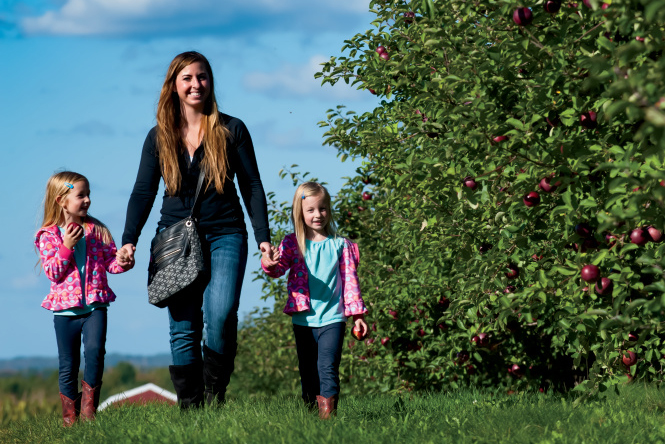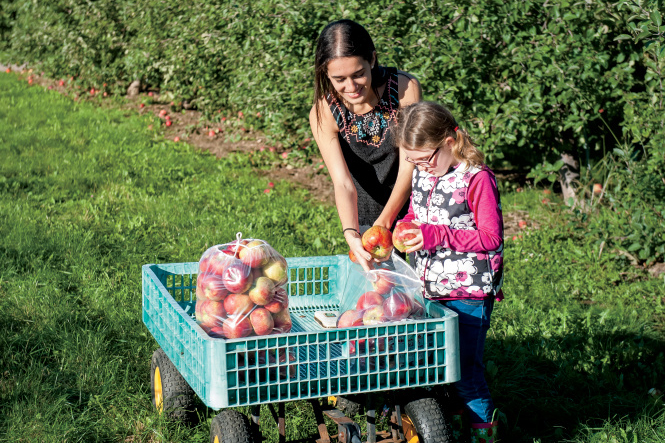Home > Wisconsin > Wisconsin Agritourism > Two Wisconsin Apple Farms to Visit This Fall
Two Wisconsin Apple Farms to Visit This Fall
In partnership with: Wisconsin Department of Agriculture, Trade and Consumer Protection.
 If you’re trying to avoid going to the doctor by eating an apple a day, head to Wisconsin. The state is one of the top apple producers in the nation, yielding millions of pounds of the all-American fruit each year.
If you’re trying to avoid going to the doctor by eating an apple a day, head to Wisconsin. The state is one of the top apple producers in the nation, yielding millions of pounds of the all-American fruit each year.
In Trempealeau, Jess Ecker helps operate Ecker’s Apple Farm along with her mother, sister and husband. The farm has been family-owned and -operated since 1945, but it was converted to an orchard in the late 1970s. Ecker says the orchard covers about 100 acres, with 40 dedicated to apple production.
They grow many different varieties, including Gingergold, McIntosh, Gala, Riverbelle, Fuji, Red Delicious and Honeycrisp.
“Honeycrisp has a beautiful color, a sweet and tangy flavor profile, and a cell structure that explodes with juice as you take a bite,” Ecker says. “It’s a great eating apple, but also bakes well. It’s a big hit when dipped in caramel and rolled in nuts and candy.”
 The farm also grows English cider apple trees and blueberry bushes that offer U-pick opportunities for customers in the summer. Ecker says that apples do well in Wisconsin, thanks to the state’s favorable climate.
The farm also grows English cider apple trees and blueberry bushes that offer U-pick opportunities for customers in the summer. Ecker says that apples do well in Wisconsin, thanks to the state’s favorable climate.
“Wisconsin’s land and climate are conducive to apple growing in general,” Ecker says. “We get just the right amount of hot and cold temperatures to support a solid growing season for apples. Good rainfall, decent sun exposure and cool autumn nights that turn apples red are some other factors that make Wisconsin a hot spot for growing apples.”
Those cool autumn nights also attract families to the farm, and Ecker’s offers lots of activities focused around apples, as well as a beer garden they added in 2014.
“We offer pick-your-own apples in September and October, and haul guests around the orchard with our tractor,” Ecker says. “We also started throwing a large farm party, the Honeycrisp Hootenanny, in mid-October each year. It’s a celebration of Honeycrisp apples, bluegrass music and beer.”
 Fresh Apples for All
Fresh Apples for All
At Helene’s Hilltop Orchard in Merrill, the majority of the apples grown on the farm’s 20 acres are sold retail through U-pick sales. Guests have the opportunity to stroll through the orchard in the fall and fill a bag with fresh apples. Afterward, they can stop by the farm’s on-site commercial bakery for a delicious caramel apple walnut muffin, apple pie, apple dumpling or apple turnover made from scratch with freshly harvested apples.
“About 80 percent of our apples go through U-pick,” says Olivia Telschow, orchard manager, who runs the farm with her mother, Helene (the orchard’s namesake), her husband and her three children. Her father, Dave, is now retired and continues to mentor her in production and care of the trees.
“The rest of the apples we harvest for ourselves to use for our bakery products,” Telschow adds. “It’s extremely important to us to use our own products in baking. We bake thousands of apple pies that have about three pounds of sliced apples in them.”
 Telschow says that Helene’s Orchard is involved in agritourism as well, and they hope to really educate consumers about apples by letting them pick their own.
Telschow says that Helene’s Orchard is involved in agritourism as well, and they hope to really educate consumers about apples by letting them pick their own.
“In the fall we have a cow train ride that goes through a corn path, along with a hay wagon ride, corn maze and barnyard play area filled with agricultural equipment for children to explore. The U-pick helps create an experience for visitors and gives them a better understanding of where the apples come from,” she says.
The orchard grows three types of apples for visitors to choose from – Cortland, Honeycrisp and McIntosh – as well as some experimental heritage trees that are used to create a robust, flavorful cider.
“Those types of apples are in high demand from hard cider producers,” Telschow says. She adds that they’re always working to please the consumer, too.
“We have a lot of experimental trees planted to see how they do,” she says. “We’re always looking to what we can add, like maybe an early-season apple. Our apples aren’t really ripe until the middle of September, but people want it earlier.”



